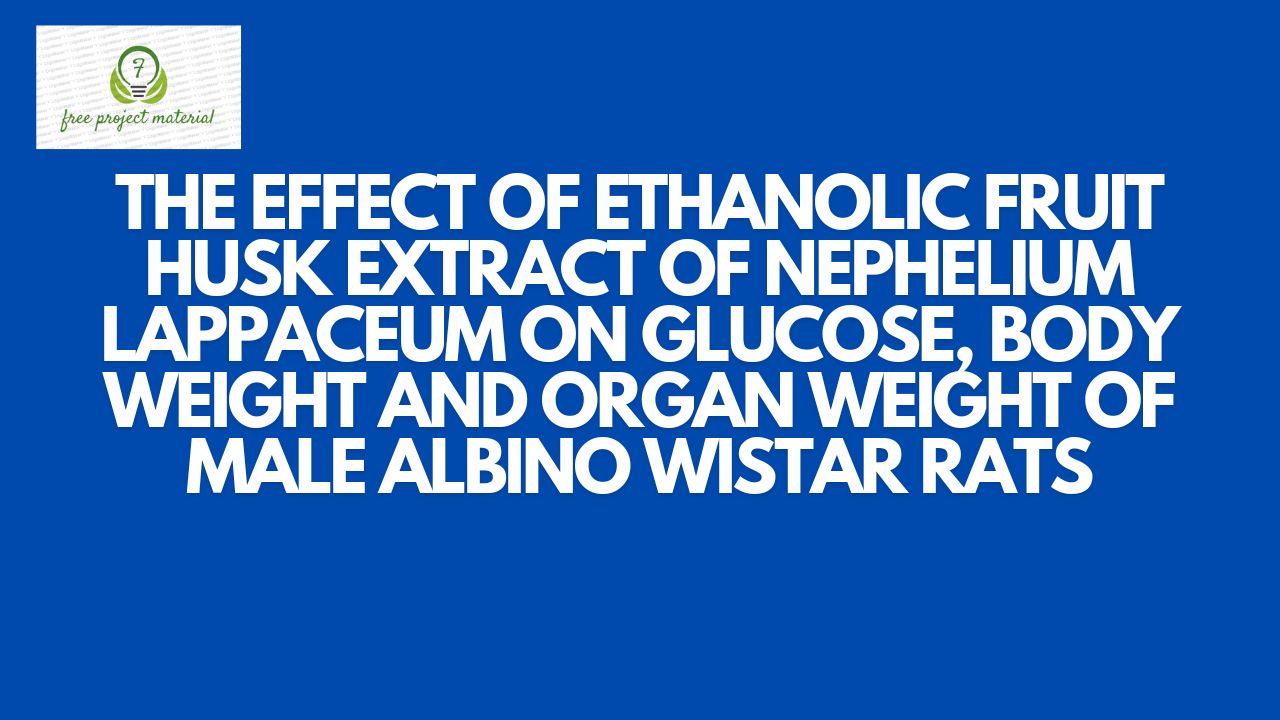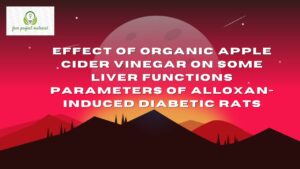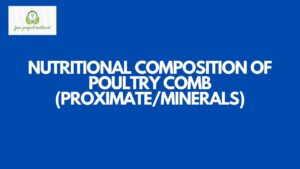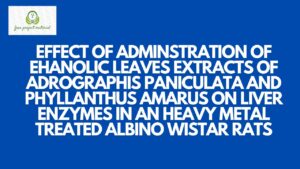ABSTRACT
The effect of ethanolic husk extract of nephelium lappaceum on the blood glucose, body and organ weight of alloxan induced male albino wistar rats, was assay using standard analytical procedures. Twenty five (25) male albino wistar rats weighing between 109-124g were randomly divided into five groups of five rats in each group. Group I served as normal control, group II served as diabetic group and was given 150mg/kg body weight of alloxan, group 111 served as the drug control group which was given 80mg/kg of metformin. Group IV and V were treated groups with 50mg and 100mg/kg body weight of extract respectively. The treatment lasted for twenty one ( 21) days. All the rats had free access to rat chow and distilled water adlibitum. The Blood glucose level decreased significantly (P<0.05) in the extract treated groups IV and V in week 2 and 3 respectively when compared with the diabetic group 2.The final body weight significantly (p<0.05) decrease in the treatment groups except group 5 when compared to the control and diabetic group as well as the metformin group. Also the organ weight of the liver,kidney,and lung in the treatment groups significantly increase (p<0.05) when compared to the control group 1, group 2(diabetic) as well as group 3( metformin) group.A significant (p<0.05) decrease was observed in the spleen,pancrease and heart, in the treatment groups when compared to the control and diabetic as well as the metformin group. The observed in the body and organ weight respectively in the treatment groups were in a dose dependent manner.This result of the analysis suggests that the administration of Nephelium Lappaceum possess the ability to reduced the glucose level of the rats, with no side effect.
TABLE OF CONTENTS
Title page – – – – – – – – –
Certification – – – – – – – –
Acknowledgements – – – – – – –
Abstract – – – – – – – – –
Table of contents – – – – – – – –
CHAPTER ONE: INTRODUCTION
- Background of the study – – – – – –
- Aim of the study – – – – – – –
- Objective of the study – – – – – –
- Significance of the study – – – – – –
- Scope and limitation of the study – – – – –
CHAPTER TWO: LITERATURE REVIEW
2.1 Description of the plant (Nephelium lappaceum) – –
2.2 Classification of N. lappaceum – – – – –
2.3 Nutritional composition of N. lappaceum – – –
2.4 Traditional uses of N. lappaceum – – – – –
2.5 Antioxidant Activity – – – – – – –
2.5.1 Antidiabetic activity – – – – – –
2.5.2 Toxicity of N. lappaceum. – – – – – –
2.5.3 Biological effect of Alloxan.
2.5.4 Mechanism of Alloxan Action. – – – – –
2.5.5 The Role of Glucose in the Body. – – – –
2.6 Relationship between Body weight and organ Weight –
2.7 Review of Related work – – – – – –
CHAPTER THREE. MATERIALS AND METHOD
3.1 Materials – – – – – – – –
3.2 Methods – – – – – – – –
3.2.1 Collection and preparation of Sample – – – –
3.2.2 Extraction of crude sample – – – – –
3.2.3 Induction of diabetes – – – – – –
3.2.4 Animal Grouping and Treatment – – – – –
3.2.5 Blood Collection – – – – – – –
3.2.6 Determination of Glucose levels – – – – –
3.2.7 Determination of Body weight organs weights – –
3.3 Statistical analysis – – – – – – –
CHAPTER FOUR Results AND DISCUSSION
4.1 Results – – – – – – – –
4.2 Discussion – – – – – – – –
CHAPTER FIVE CONCLUSION AND RECOMMENDATIONS
5.1 Conclusion – – – – – – – –
5.2 Recommendation – – – – – – –
References – – – – – – – –
CHAPTER ONE INTRODUCTION
1.1 Background of the Study
There is an increase in demand in developing drugs or alternative therapy with the side effects using some natural product as potential antidiabetic drugs in managing hyperglycemia. Rambutan (Nephlium lappaceum L). it is a subtropics fruit from the family Sapindaceae found abundantly in Malaysia. It is kind of fruit appreciated for it’s refreshing taste and is consumed fresh, processed also in canned form (Palanisamy et al., 2008). The peel of N. lappceum has an antioxidant and antiglycemic properties.
The methanolic and aqueous extracts of lyophilized rambutan peels and seeds were evaluated for phenolic contents, antioxidant and antibacterial activities (Palanisamy et al., 2011a; Thitilertdecha and Rakariyatham, 2011). Geranium, which is an ellagitannin is reported to be the main active compound in the N. lappaceum rind extracts.
Medicinal plants are utilized by human beings and other animals not only as a source of nutritional contents but are also important in the process of making medicinal drugs as an alternative in the treatment of such disease as diabetes, hypertension, ulcers infection disease amongst others (Brunzell et al. (2008).
Glucose in the immediate sources of energy for cellular activities and it’s homeostasis has to be constantly maintained within the normal range. The alteration in glucose levels provides useful information concerning the status of glucose metabolism. Glucose and body weight abnormalities plays a major role in the development of several disease conditions (Etim et al., 2008). Increased blood glucose (hyperglycemia) leads to diabetes, a chronic metabolic disorder due to insulin insufficiency (Adefegha and Oboh, 2011). Increased body weight (obesity ) act as a diabetogenic factor and lead to decrease insulin receptors on it target cells (Edet et al., 2011).
However several synthetic antidiabetic agents have been formulated to circumvent this condition. however these synthetic agents produce some serious side effects to the detoxifying role of the live (Emeka and Obiona 2009). Therefore, the guest for effective, low cost and less side effects producing hypoglycemic agent is important.one of such plants reported to have therapeutic potential is N. lappaceum belonging to the family sapindaceae.
Alloxan is an hydrophilic and an unstable chemical compound that has similar shape to that of glucose, which is responsible for its selective uptake and accumulation by the pancreatic beta cell. Similarity in shape allows it’s transports into the cytosol by the glucose transporter (GLUTZ) in the plasma membrane of beta cell (Elsneret al., 2002).
Alloxan is a diabetogenic agent that impairs the synthesis of insulin through the destruction of islet cell of langerhan of the pancreas resulting to a rise in the glucose level in the system.
1.2 Aim of the Study
The study aimed at determining the effect of ethanolic husk extract of N. lappaceum on the blood glucose level body and organ weights respectively on alloxan induced diabetic male albino Wistar rats.
1.3 Objectives of the Study
The following were the objectives of the study
- To determine the effect of Nephelium lappaceum on the (blood glucose level) of alloxan induced diabetic male albino Wistar rats.
- To determine the effect of Nephelium lappaceum on the (body weight) of alloxan induced diabetic male albino Wistar rats.
- To determine the effect of Nephelium lappaceum on the (organ weight) of alloxan induced diabetic male albino Wistar rats.
1.4 Significance of the Study
Diabetes mellitus s one of the clinical condition affect people particularly the aged individual. This condition can also aggravate and predispose some one. To other clinical disorder such as cardiovascular diseases. However severed formulations in the form of drugs have been used to manage diabetes. The use of these formation also has it’s adverse effect such as hepatotoxic effect as well as high cost. Therefore, it’s imperative to assess the effect of this plant on the glucose concentration since several medical reports have been document on the effectiveness of the plant and to make recommendation on the use of this plant for the management of diabetes instead of the used synthetic drugs.
1.5 Scope and limitation of the study
The study majorly focused on assessing the effect of ethanolic husk extract of Nephlium lappaceum on the blood glucose, body and organ weights of alloxan induced males albino Wistar rats. This was limited by time as well as financial constraints and the level of study.



